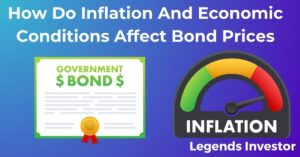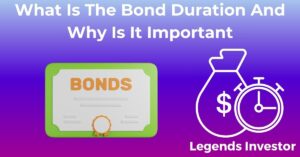Introduction to Bond Yield: A Primer for Investors
Bond yields are a fundamental aspect of the fixed-income market, crucial for investors seeking stable returns. Understanding bond yield is essential for making informed investment decisions and navigating the complexities of the bond market. This article provides a comprehensive overview of bond yield, its significance, and how it influences investment strategies.
Delving into Bonds: The Basics
Definition of a Bond and Its Purpose
A bond is a fixed-income security that represents a loan made by an investor to a borrower, typically a corporation or government entity. The borrower agrees to pay interest on the borrowed amount (the coupon) at regular intervals and to repay the principal amount (the face value) at maturity. Bonds are used by issuers to raise capital for various purposes, including funding projects or managing debt.
Different Types of Bonds
Bonds come in various types, each with unique characteristics:
- Government Bonds: Issued by national governments, these bonds are generally considered low-risk and include Treasury bills, notes, and bonds.
- Municipal Bonds: Issued by state and local governments, municipal bonds fund public projects and often come with tax advantages.
- Corporate Bonds: Issued by companies to raise capital, corporate bonds tend to offer higher yields than government bonds but come with higher credit risk.
How Bonds Work as a Fixed-Income Investment
Bonds are fixed-income investments because they provide regular interest payments (coupons) and return the principal amount at maturity. This regular income stream makes bonds attractive to investors seeking predictable returns and lower risk compared to equities.
Unlocking the Mysteries of Bond Yield
Definition of Bond Yield
Bond yield represents the return an investor can expect to earn from a bond. It reflects the bond’s income relative to its price and can be expressed in various ways, including current yield and yield to maturity (YTM).
The Difference Between Yield and Coupon Rate
- Coupon Rate: The fixed interest rate paid by the bond issuer, expressed as a percentage of the bond’s face value.
- Yield: The bond’s overall return, which can vary based on the bond’s price and the time to maturity. Yield takes into account both the coupon payments and any potential capital gains or losses.
Why Bond Yield Is a Crucial Metric for Investors
Bond yield is a critical metric because it helps investors assess the potential return on their investment. It allows comparison between different bonds and other investment options, guiding decisions based on risk and return expectations.
The Mathematics of Bond Yields: A Step-by-Step Guide
How to Calculate the Current Yield of a Bond
The current yield is calculated as follows:
Current Yield=Annual Coupon PaymentCurrent Bond Price\text{Current Yield} = \frac{\text{Annual Coupon Payment}}{\text{Current Bond Price}}Current Yield=Current Bond PriceAnnual Coupon Payment
For example, if a bond with a face value of $1,000 pays $50 in annual interest and is currently priced at $950, the current yield is:
Current Yield=50950≈5.26%\text{Current Yield} = \frac{50}{950} \approx 5.26\%Current Yield=95050≈5.26%
Understanding Yield to Maturity (YTM) and Its Calculation
Yield to maturity (YTM) represents the total return an investor can expect if the bond is held until maturity. It considers the bond’s current price, coupon payments, and time remaining until maturity. The YTM calculation involves solving the following equation:
Current Price=∑t=1nCoupon Payment(1+YTM)t+Face Value(1+YTM)n\text{Current Price} = \sum_{t=1}^{n} \frac{\text{Coupon Payment}}{(1 + \text{YTM})^t} + \frac{\text{Face Value}}{(1 + \text{YTM})^n}Current Price=∑t=1n(1+YTM)tCoupon Payment+(1+YTM)nFace Value
Where:
- nnn = Number of periods until maturity
- ttt = Each period
Calculating YTM often requires iterative methods or financial calculators.
Examples to Illustrate Bond Yield Calculations
Consider a bond with a face value of $1,000, a 6% coupon rate, and a 5-year maturity. If the bond is priced at $950, the current yield is:
Current Yield=60950≈6.32%\text{Current Yield} = \frac{60}{950} \approx 6.32\%Current Yield=95060≈6.32%
To calculate YTM, you would solve for the discount rate that equates the present value of the bond’s cash flows to its current price, often using a financial calculator or software.
Market Dynamics: Factors Influencing Bond Yields
The Relationship Between Bond Prices and Yields
Bond prices and yields have an inverse relationship. When bond prices rise, yields fall, and vice versa. This relationship occurs because the bond’s fixed coupon payments represent a larger portion of the bond’s price when the price decreases, resulting in higher yields.
Interest Rate Movements and Their Impact on Bond Yields
Interest rates and bond yields are closely related. When interest rates rise, newly issued bonds offer higher yields, making existing bonds with lower yields less attractive, which leads to a decrease in their prices and an increase in their yields. Conversely, falling interest rates lead to rising bond prices and decreasing yields.
The Role of Economic Indicators and Their Influence on Bond Yields
Economic indicators, such as inflation rates, employment data, and GDP growth, impact bond yields. For instance, higher inflation can erode the purchasing power of future bond payments, leading to higher yields. Central bank policies and economic growth expectations also play significant roles in determining bond yields.
Deciphering Yield Curves: Predicting Economic Shifts
What a Yield Curve Is and What It Signifies
A yield curve is a graphical representation of bond yields across different maturities. It shows the relationship between interest rates and bond maturities, providing insights into future economic expectations.
Understanding the Different Shapes of Yield Curves
- Normal Yield Curve: An upward-sloping curve indicating higher yields for longer maturities, reflecting expectations of economic growth and rising interest rates.
- Inverted Yield Curve: A downward-sloping curve suggesting lower yields for longer maturities, often signaling economic slowdown or recession.
- Flat Yield Curve: A horizontal curve indicating similar yields across different maturities, suggesting uncertainty about future economic conditions.
How Yield Curves Help Predict Economic Changes
Yield curves help predict economic shifts by reflecting investor expectations. An inverted yield curve, for example, may indicate an impending recession, while a steepening curve suggests expectations of robust economic growth.
Risks and Returns: Assessing Bond Yields
The Balance Between Yield and Risk in Bond Investments
Investors must balance yield and risk when evaluating bond investments. Higher yields often come with increased risk, such as credit risk or interest rate risk. Assessing the risk-return profile helps investors make informed decisions based on their risk tolerance and investment goals.
Credit Risk and Its Effect on Bond Yield
Credit risk, or default risk, affects bond yields. Bonds with higher credit risk offer higher yields to compensate investors for the increased likelihood of default. Ratings agencies provide assessments of credit risk, influencing bond yields and investment decisions.
Comparing Bond Yield with Other Investment Yields
Comparing bond yields with other investment yields, such as stocks or real estate, helps investors evaluate relative attractiveness. Bonds typically offer lower yields than equities but provide stability and lower risk, making them suitable for risk-averse investors.
Beyond the Numbers: Real-World Implications of Bond Yields
Case Studies Showing the Impact of Bond Yields on Investment Portfolios
Case studies highlight how bond yields impact investment portfolios. For example, during periods of rising interest rates, bond prices may fall, affecting portfolio values. Conversely, declining interest rates can boost bond prices and improve portfolio returns.
The Influence of Bond Yields on Government Policies and Spending
Bond yields influence government policies and spending. High yields can increase borrowing costs for governments, leading to reduced public spending or changes in fiscal policy. Conversely, low yields may encourage increased borrowing and spending.
How Bond Yields Can Signal Broader Market Trends
Bond yields can signal broader market trends, such as economic growth or recession. For instance, a rising yield curve may indicate confidence in economic expansion, while a flattening or inverted curve can signal potential economic challenges.
Staying Informed: Monitoring Bond Yield Fluctuations
Tools and Resources for Tracking Bond Yields
Investors can track bond yields using financial news websites, market data platforms, and financial news apps. Tools like yield calculators and bond market indices provide real-time information on bond yields and market trends.
Tips for Interpreting Changes in Bond Yields
Interpreting changes in bond yields involves understanding the underlying economic factors and market conditions driving those changes. Regularly reviewing economic indicators, central bank policies, and global events can provide insights into bond yield movements.
The Importance of Staying Updated on Bond Market Trends for Long-Term Investment Strategies
Staying updated on bond market trends is crucial for long-term investment strategies. Monitoring bond yields helps investors make informed decisions, adjust portfolios, and navigate market changes effectively.
Conclusion
Understanding bond yields is essential for making informed investment decisions and navigating the complexities of the bond market. By grasping the basics of bond yields, market dynamics, and real-world implications, investors can enhance their investment strategies and achieve their financial goals. Staying informed and continuously monitoring bond market trends ensures a well-rounded approach to bond investing.



